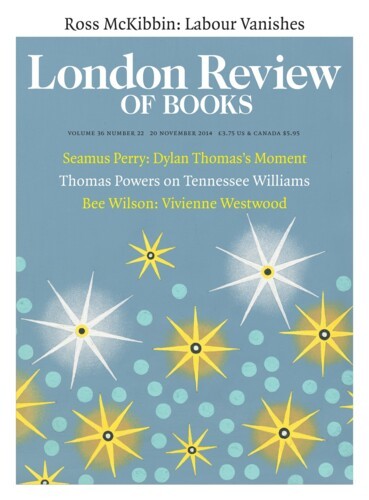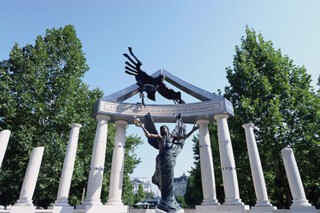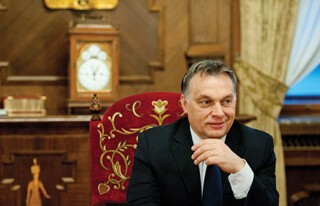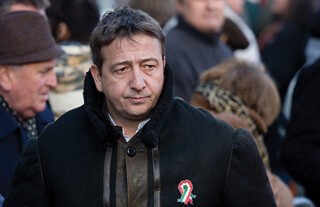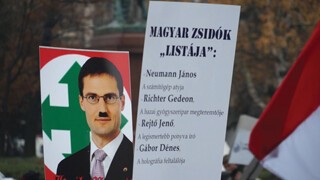This summer , a new monument appeared in Budapest’s Liberty Square. Amid a copse of truncated white marble pillars stands the metal figure of a slender young man. Wrapped from hips to feet in windswept drapery, he opens his arms to the sky. In his right hand he bears the orb of political authority surmounted by the Hungarian double-barred cross. Wings sprout from his shoulder blades. His expression is one of seraphic tranquillity, which is odd, because swooping down on him is a monstrous eagle bolted together from shards of gleaming black metal, its features convulsed into a mask of malevolence, its talons poised to snatch the orb. The young man is the archangel Gabriel, newly engaged as patron and symbol of the Magyar nation. The eagle (though it bears an uncanny resemblance to the bird that decorates the German Bundestag today) represents Nazi Germany. The monument commemorates the German invasion of Hungary in March 1944.
Liberty Square has long been a space where memories of the Hungarian past are contested. The square itself is the result of an act of historical erasure. It extends across the space once occupied by the Újépület barracks, in which Hungarian national leaders were imprisoned by the Austrians in the aftermath of the Revolutions of 1848-49. Today it boasts both an imposing monument over the grave of Red Army soldiers killed in the siege of Budapest, one of the last Soviet memorials left in the city, and a life-sized statue of a grinning Ronald Reagan, erected in 2011. Even the Soviet war memorial sits on the foundations of an earlier monument that mourned the lands taken from Hungary under the terms of the Treaty of Trianon, imposed by the victors of the First World War.
From early April, when construction began, there have been demonstrations every afternoon against Budapest’s latest national memorial. Armed police guarded the building site, videoing protesters and demanding to see identity cards. The structure was completed at the dead of night and there was no public unveiling ceremony. It is still under police guard. There has been a chorus of criticism from historians, art critics and other public intellectuals in Hungary and abroad. It is hard to disagree with the Hungarian art historian József Mélyi, who described the memorial as ‘academic kitsch with faulty symbolism and execution’.
But the roots of the current controversy lie in the iconography of the monument itself. The eagle swoops from a stylised classical pediment inscribed with the words ‘To the Victims of the German Occupation’. The message is reinforced by a stone slab bearing the English dedication ‘To the Memory of Victims’, with translations in German, Russian and Hebrew, though the text is unidiomatic in every language (the Hebrew phrase has been split in two and the sections carved in the wrong order by someone unaware that Hebrew is read from right to left).
The monument portrays the Hungarian nation, represented by an angelic figure, as the hapless ‘victim’ of Nazi violence. In fact, Hungary was one of the chief beneficiaries of Axis policy. Under the First Vienna Award of 1938, Germany and Italy presented Hungary with territory in Czechoslovakia and Subcarpathia. In 1939, the Hungarian army occupied the rest of Subcarpathia and part of eastern Slovakia. Following the Second Vienna Award of 1940, Hungary reclaimed Northern Transylvania, lost under the terms of the Trianon Treaty, and later joined in the invasion of Yugoslavia, securing yet more territory. On 27 June 1941, five days after the German invasion of the Soviet Union, the Hungarian prime minister László Bárdossy declared that a state of war had ‘occurred’ between Hungary and the Soviet Union and the country entered the war on the side of the Axis.
The monument’s treatment of the war’s Jewish victims is particularly problematic. The Hungarian holocaust that followed the German occupation in early 1944 was one of the most horrific in Europe: a Jew living in the Hungarian countryside in March that year had a less than 10 per cent chance of surviving until the end of the war. The figure for Budapest Jews was around 50 per cent. Most of these people perished after being deported to the Nazi death camps. But focusing on these facts in isolation obscures Hungary’s agency in the discrimination, persecution and murder of Jews, both before and after the occupation. There had been restrictions on Jews taking places at Hungarian universities since Horthy came to power in 1920: he had committed himself to curtailing the ‘Jewish influence’ on public life. Twenty-one ‘Jewish laws’ passed by the Hungarian Parliament and 267 ministerial edicts issued between 1938 and 19 March 1944 progressively deprived Jews of all rights and prohibited intermarriage or sexual relations between Jews and non-Jews. There were pogroms in Kisvárda in 1938 and in Munkács and Máramarossziget in 1942. In 1941, the forced deportation of 17,000 Jews from areas newly occupied by Hungary to Kamenetz-Podolski (in today’s Ukraine) led to their mass murder, carried out initially by Ukrainian auxiliaries and later by German units operating in the area. Hungarian Jews were also forcibly conscripted into labour service for the army and in 1941-42 sent unarmed to the eastern front as auxiliaries.
Hungary, it’s clear, wasn’t a haven for the Jews before 1944; and the extermination of Hungarian Jews wasn’t the work of the German occupiers alone. The governing structures of the Hungarian state were left largely intact by the Germans and Horthy remained formally in power, taking part in appointing the new government. Only two ministers in the post-occupation cabinet had not been members of his government. As for the removal of 437,000 Hungarian Jews to German-run killing facilities in Poland over 57 days in the early summer of 1944 (one of the most intense phases of extermination in the Holocaust), this was primarily accomplished not by the small German Einsatzkommando deployed in Hungary, but by Hungarian gendarmes and officials, who saw to it that the deportations proceeded with exemplary efficiency. Hungarians carried out body searches, and inflicted beatings to extract information on the whereabouts of hidden valuables. In October 1944, after seeking a separate peace with the Soviet Union, Horthy was forced to abdicate and replaced by a puppet regime run by the home-grown fascist movement Arrow Cross. The brief period of Arrow Cross rule saw further waves of killing by Hungarian fascists of suspected Jewish ‘partisans’, returnees from the Jewish forced labour battalions, poorhouse inmates and even patients in Budapest’s two Jewish hospitals. It is worth noting the contrast between Hungary and France, where Jews stood a much better chance of survival, despite a much longer period of German occupation.
In depicting the occupation as an assault by a monstrous Nazi eagle on an angelic Hungarian nation, the monument on Liberty Square grossly distorts the historical and moral complexity of the events it claims to be commemorating. This is precisely what has aroused the ire of the critics. But there would surely have been less heat in the opposition if this monument were not just one manifestation of a larger and more alarming phenomenon: a concerted campaign by the current Hungarian government to resculpt the public memory of the nation’s past.
In the preamble to the new Hungarian constitution or Fundamental Law that took effect in 2012, the date 19 March 1944, when the German army occupied the country, is declared to be the moment Hungary lost its sovereignty as a state, regaining it only in 1990. The four decades of communism are thus equated with the nine months of German occupation as periods of alien rule. One effect of this restructuring is the rehabilitation of Horthy’s authoritarian regime, which has been surgically separated from the ‘crimes of Nazism’.
Statues of Horthy have begun to sprout in Hungarian squares in recent years and the language of his era is back in vogue. His regime stated its belief in the ‘Christian national course’ and the preamble of the 2012 Fundamental Law includes a ‘national avowal’ in the name of the ‘members of the Hungarian nation’: ‘We are proud that our King St Stephen a thousand years ago placed the Hungarian state on stable foundations, and made our fatherland a part of Christian Europe … We recognise the role of Christianity in conserving the nation.’
The grandiloquent constitutional flourishes were backed up by the new penal code introduced on 1 July 2013, under which publicly insulting or demeaning national symbols – the national anthem, the national flag, the Hungarian coat of arms or the Holy Crown, a medieval crown once believed to be that of St Stephen – is punishable by up to a year’s imprisonment. The new vision of the past is also to be promulgated in schools: since September, Hungarian schools have been obliged to choose between three government-approved history textbooks, one of which has been widely condemned by teachers for presenting Hitler in a positive light.
Hungary’s new past is compellingly on display in the House of Terror, which opened in 2002, during Fidesz’s first term in office, in the Budapest building that served as the headquarters of the Arrow Cross and, later, of the ÁVH – Hungary’s version of the Stasi. Over 23 rooms the House of Terror represents Hungarian history since 1944 as a tale of unremitting persecution, first by the Nazis and Arrow Cross (to whom two rooms are dedicated) and then by the communists. Here, again, it is ‘the Hungarians’ who are the victims, first of German Nazism then of a communism imposed by the Kremlin and sustained by a fifth column of agents. Who exactly these agents were remains tantalisingly unclear, but there is a large room dedicated to the early postwar head of the secret police, Gábor Péter, who, as it happens – and this is a fact known to all adult Hungarians – was Jewish by descent. A Hungarian Jew, or at least a man identified as such by most Hungarians, appears more prominently in the role of perpetrator in the House of Terror than Hungarian Jews do in the role of victims. This pattern of representation makes sense only if one bears in mind the widespread if often implicit equation in today’s Hungary of communists and Jews. First ‘we’ were terrorised by the Germans, then ‘we’ were terrorised by the communists/Jews.
The Hungarian government declared 2014 the year of the commemoration of the Hungarian Holocaust, but its projects have all displayed an abridged version of the past which minimises Hungarian responsibility. While the House of Terror is generously funded, the Holocaust Memorial Centre has been deprived of money and even of a director: when the term of the last director expired this spring, the post was not advertised. Small wonder that the largest Jewish umbrella organisation declared a boycott of the government’s Holocaust Commemoration Year. It returned the money it had received from the government and is now trying, through the Memento70 organisation, to raise money to commemorate the dead with dignity.
No observer of Hungarian politics can fail to see how the terrain of public discourse has shifted. What matters to the political culture of a democracy is not what people think, but what they feel empowered to say in public. The great achievement of West Germany after 1945 was not to have cleansed the ideas of National Socialism from the heads of millions of former adherents, but – initially under pressure from the western Allies and later through internal cultural ferment – to have gradually transformed the West German public sphere into a space where racist and anti-Semitic utterances had no place. On 26 November 2012, by contrast, the Jobbik MP Márton Gyöngyösi demanded that a list of Jewish members of parliament be drawn up, on the grounds that these individuals posed a ‘national security risk’. Zsolt Bayer, a journalist and former media adviser to Fidesz, wrote that the Roma should be ‘made to disappear’ because they ‘behave like animals’. Jobbik MPs have claimed that they can provide material proof of the Jewish ritual murder of Christian children.
Such statements have created the false impression in the Western media that the problem in Hungary lies in the resurgence of the extreme right, and specifically of Jobbik, the self-declared ‘radically patriotic Christian party’ that gained just over one-fifth of the votes in this year’s elections, making it the third largest party. But while there is no doubting that Jobbik’s deputies and leaders are given to making anti-Semitic, anti-Roma and homophobic outbursts, the focus on the far right obscures the part played by the government, which has presided over and encouraged the transformation of public debate. Early in June 2014, the Supreme Court – itself the subject of attacks and attempts by the government to pack the court – ruled that Jobbik couldn’t be described as ‘far right’ in domestic radio or television broadcasts, on the grounds that the party itself rejected that description. Sándor Szakály, the director of the Orwellian Veritas Institute, a historical ‘research facility’ set up under the aegis of the prime minister’s office, described the mass deportation of Jews to Kamenetz-Podolski in 1941 as merely a ‘police procedure’ mounted against illegal ‘aliens’. The gauche, pseudo-theological response of the prime minister, Viktor Orbán, to the upsurge of anti-Semitism revealed the extent to which the Jews have been ‘othered’ out of the official discourse of Hungarian history and identity: ‘Many people think that the Jews are stronger and want to harm them,’ Orbán told an Israeli newspaper in May 2013. ‘They have no intention of harming us. I explain to people that it is prohibited for us to see Jews as a danger; instead we must see them as the gift of God.’
We could dismiss all this as a phase, part of the post-communist readjustment. It is hardly surprising that the pendulum has swung back after decades of history management by the communist regime (though its interventions look quite restrained in retrospect) – and the pendulum of history almost always swings too far. One might also argue that this shows that Hungary’s democracy is in rude health. After all, the Fidesz-KDNP government can only set the tone because it accounts for two-thirds of the members of parliament. As Tibor Fischer observed in a piece for the Guardian bewailing the ‘hysteria’ of European media coverage of Hungary, Orbán ‘was voted into office and has the right to get things wrong’.
True enough. But what if the current government were to succeed in transforming the framework of public discourse in Hungary, dismantling in the process the legal and constitutional machinery that provides a meaningful check on government authority? What if the pendulum is nailed to the wall before it can swing back? The alterations the government has made to the constitution and the law protecting the dignity of the nation suggest that this is its objective. Recent efforts to bring the media under government control reinforce that impression. The 2010 media law, passed quickly and without consultation, restricted media freedom. The prime minister now appoints the president of the National Media Authority, which controls the media, oversees its regulation and imposes sanctions. A media commissioner, appointed by the president of the NMA, can investigate any issues without having to prove that the law has been violated, simply in order to ‘protect community interests’. Journalists are required to reveal their sources at the NMA’s request, and anyone impeding its investigations can be fined. Public media must use the stories provided by the Hungarian News Agency. Major newspapers and magazines, including the free newspaper distributed on the Budapest underground, have been bought up by government-friendly oligarchs. Since 2010 the agency for Hungarian tourism and the official gambling agency, Gaming Ltd, have bought millions of forints’ worth of advertising space in government-controlled newspapers, but none at all in independent publications. In rural areas, where news is distributed to the media through local councils, opposition media are simply omitted from the list of recipients. The discrimination can take quite petty forms, as it did recently when opposition journalists were refused entry to events organised by the government – the opening of a football stadium, for example.
For three and a half years, the NMA withheld permission for Klubrádió, an independent radio station that broadcasts news and analysis, to transmit free of charge on the frequency it had lawfully acquired, forcing it instead to pay a high price to use a different frequency. The NMA also tried to control the station’s programming by imposing a limit on the proportion of news content. When the matter was taken to court Klubrádió won, but the judgment was nullified because parliament passed a new media law with retroactive effect. Klubrádió won again in the appeal courts, but the NMA did not implement the judgment for six months, further undermining the station. In June 2014 the NMA closed down the Klubrádió frequency in Debrecen, a major provincial centre.
The case of Klubrádió suggests that the Hungarian judiciary remains capable of providing some protection of media freedom. But there are other problems. The new constitution prohibits the constitutional court from reviewing cases dealing with public finances and new rules make it difficult for opposition parties to bring cases before the court. The president of the National Judicial Office, established by the government in February 2012, has the right to appoint new judges. The government decides whether or not these judges are reappointed after their probationery period is up, an arrangement unlikely to foster a spirit of political neutrality. The head of the National Judicial Office also has the power to move, promote, demote or discipline judges.
Even the electoral system has been overhauled. Before the 2014 elections, the number of seats in parliament was reduced from 386 to 199. Half a million citizens of neighbouring countries who define themselves as ethnically Hungarian were given the vote, which they could cast by post, while Hungarian citizens who had moved abroad – a group highly likely to harbour liberal and left-of-centre sentiments – had to fight their way through a difficult registration system and, if they managed to register, which many didn’t, were required to vote in person at the nearest Hungarian embassy, for many a prohibitively expensive journey. There are doubts, too, about whether the opposition parties can compete on equal terms with the government. On 11 July, the Organisation for Security and Co-operation in Europe reported that in the elections ‘the main governing party enjoyed an undue advantage because of restrictive campaign regulations, biased media coverage and campaign activities that blurred the separation between political party and the state.’
Meanwhile, those who criticise the government are harassed by the tax authorities or even fired from their jobs. On 10 July 2012, the Human Rights Court in Strasbourg condemned Hungary for firing government officials without providing any justification. The government has raided NGO offices and blocked the transfer of funds by the Norwegian NGO Fund to a range of Hungarian NGOs, including the Roma Press Agency, the Rainbow Association (for gay rights), the Foundation for Democratic Youth and the Hungarian branch of Transparency International, on the grounds that these are all ‘anti-government organisations’. When an independent online paper interviewed experts on matters of public interest, more than two-thirds of the respondents asked to remain anonymous.
What does all this mean? For one thing, it’s not a temporary resurgence of the ‘far right’ in response to economic stress, but a fundamental realignment of political culture, achieved through a combination of populism, intimidation, the distribution of spoils to loyalists, and authoritarian tampering with Hungary’s constitutional, electoral and legal structure. The results can be seen in virtually every sphere of public life, from the extra-legal razing of Roma ‘slums’ to museums, monuments and education, from media regulation to the renaming of streets and squares.
The European Community was founded after the darkest period of European history, in the hope that it would safeguard democracy, create prosperity and foster reconciliation. Under the ‘Copenhagen criteria’ agreed by the European Council in 1993, the conditions for accession to the EU include ‘stable institutions guaranteeing democracy, the rule of law, human rights and respect for and protection of minorities’. In the last decade or so the EU has acquired new members in regions that have only a fragile democratic tradition. Some of them, like Hungary, don’t meet the Copenhagen criteria. The time has come to confront governments like Orbán’s, which choose undemocratic and illiberal forms of rule, unleashing hate speech, making use of the politics of exclusion and reawakening nationalism.
Send Letters To:
The Editor
London Review of Books,
28 Little Russell Street
London, WC1A 2HN
letters@lrb.co.uk
Please include name, address, and a telephone number.
